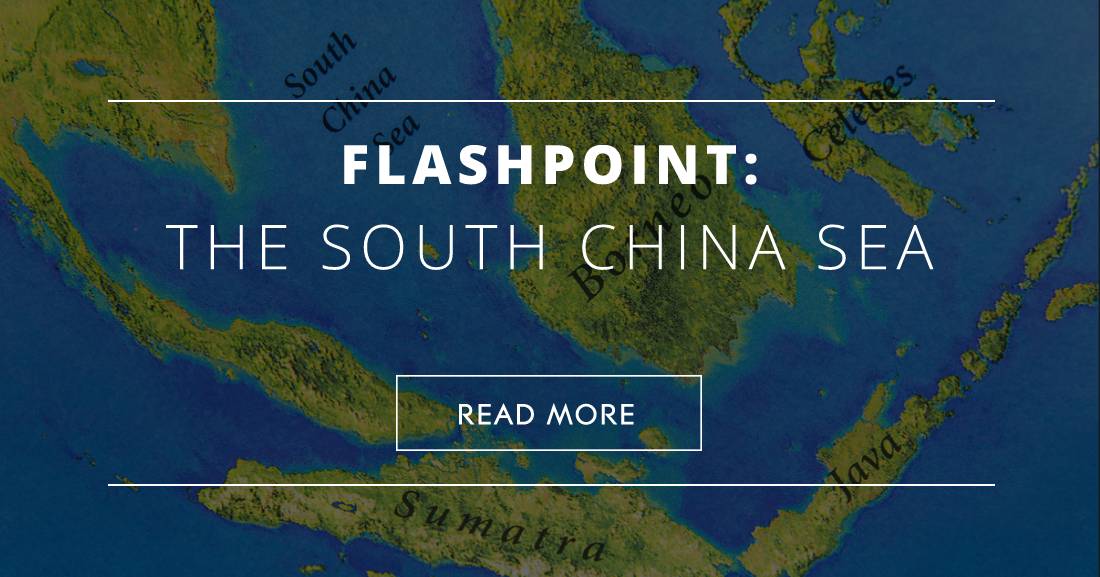Dragon Rising: Five ESL Topics for Understanding China’s Growing Influence


John Lennon begins one of his 1967 masterpieces with, “I read the news today, oh boy…” If you have a TV, or internet access, or listen to the radio, you’re probably feeling the same. The world seems packed with real or potential flashpoints, from Syria to Afghanistan and from Korea to Russia. Then, there are the recent referenda and elections in Britain, the US, Turkey and France, all of which will have major implications for the future.
Any of these events can provide fascinating material for upper-intermediate and advanced ESL classes, and I would add to this list the ongoing diplomatic and military standoff in the South China Sea. This interlocking complex of disputes and historical claims has been quietly bubbling in the background while the media rightly focuses on the refugee crisis, climate change, and the unpredictable implications of the Trump presidency. In truth, there is unlikely to be an actual ‘shooting war’ centered on these remote islands and, up until now, diplomatic channels have avoided an all-out confrontation.
However, there have been ominous signs that China, in particular, is consolidating their de facto control of many of the islands. This has brought rising tensions relating to potential oil and gas fields, as well as the all-important freedom of navigation through an area of enormous strategic importance.
Take a look at this region, which occupies the sea-space between South China, Vietnam, the Philippines and Indonesia. The various islands are scattered across a vast area of open sea, grouped by ancient volcanic activity into remote archipelagos. In and of themselves, the islands would appear as unimportant as any of the thousands of uninhabited sandbars and atolls which dot the Pacific and Indian oceans. They’re truly miniscule (some don’t even rise fully above the waves) and offer little or no safe harbor for visiting ships; most lack a supply of fresh water, or even timber. For a long time, no one wanted them, and they were contested only by the occasional pirate or would-be tyrant. So why have they found themselves at the eye of a diplomatic storm?
Their importance lies in their strategic position. Locate Singapore and Hong Kong on a map, and you’ll soon see how a vast amount of trade necessarily passes through the area around the Spratly and Paracel islands. A nation in possession of these islands could exercise sea and air dominance over this crucial waterway, shutting down trade, intimidating its geopolitical adversaries, and forcing shipping to take a much longer, more expensive route.
If this seems farfetched to your students, show them how the British Empire purposely targeted and occupied strategic positions at the world’s maritime choke points – the Suez Canal, the horn of Africa (British Somaliland and the island of Soqotra), the Cape of Good Hope, Cape Horn (the Falkland Islands), the Straits of Malacca (Singapore), etc.
The area has rich fishing grounds, but many of the territorial claims seem predicated on long-standing assumptions regarding potentially massive oil and gas fields. It’s not an easy area to explore, and test results have provided only partial justification for this interest.
A nation which possesses an overseas territory controls not only the land, but the sea around it. Depending on the nature of the claim, this can extend two, twelve or hundreds of miles from the shoreline. Suddenly, then, a nation would find itself in de facto control of a massive area of sea space, including its fish stocks and resources which might exist on the seabed.
The ability to express sovereignty and control over a broad distance is a hallmark of global reach, diplomatic confidence and military strength. If we renew our search for the remaining British Overseas Dependencies, we’ll find tiny islands from the eastern Pacific (the Pitcairn group) to the south Indian Ocean (the Chagos Archipelago), to the mid-Atlantic (St. Helena, Ascension) and the Caribbean. Most of these were important refueling bases, contained valuable economic resources, or provided regional administrative centers. The laborious creation of this expensive, long-term infrastructure furthered the British policy of exercising control over diplomacy and trade, even ten thousand miles from London. In a smaller but significant way, control over the South China Sea islands expresses the same confidence, and a willingness to extend influence beyond one’s own borders. It is, perhaps, a measure of national unity and patriotism, a demonstration to the world that this nation, and this government, are not to be trifled with.
Briefly look at the moments in history where these disputes have flared into military conflict. These have tended to be brief, nasty exchanges of naval gunfire. Remind your students that many major conflicts have begun in just such a way, with low-ranking soldiers making hasty decisions and inflaming an already tense situation. The author Tom Clancy, and others, have posited the South China Sea as a flashpoint which might lead to violence between the US and China.
Territorial and economic disputes are ripe for negotiation exercises. I take every opportunity to pose my students knotty, complex issues and require them to find a negotiated solution which avoids conflict and pleases everyone (as much as that’s ever possible!)
In this case, I had to think carefully. Several of my advanced students are from the region, and I didn’t want nationalistic fervor to complicate the exercise. Instead, I redesigned the South China Sea on the board, with the groups of islands in realistic positions, but I transformed the surrounding nations into notional, hypothetical, equal states with fictional flags. As I had played another of my games, United Nations, with this same group, I stuck with the fictional nations of Telgusia, Borkazia and Ramariya. I’d recommend names which lack any kind of connotation (Westland and Eastland might be problematic, for example); try basing fictional country names on geographical or natural features (Montland, Lakeland, Arboria, Coralia, etc)
I assigned two areas of demarcation to each nation; a ‘line of control’ which delineated their present de facto possessions, and another (dotted) line indicating their claims. Each island was given a number to avoid any messy linguistic connotations. Then I included patches of potential natural resources – oil (black) gas (light blue), fisheries (pink) and seabed minerals (green). These were designed to provoke the greatest possible overlap and conflict between the groups. I’d recommend preparing this map before class, on a whiteboard or blackboard you can hide until it’s needed, on a slide to be shown on a projector, or in a minimized image window on a computer.
Divide the class into groups, assigning each a fictional nation. Have them assess their present territorial position, and how this differs from their historical claims. I like to secretly give each nation its own ‘character’, best expressed on a card seen only by them. This can be based on:
Here are some sample cards from the most recent version of this game:
Telgusia is in urgent need of access to cheap natural gas deposits. A cruel winter has left our citizens impoverished by ruinously high oil prices, and gas heating is the only reasonable alternative. We cannot risk a war, as our navy is tiny and we do not possess a long-range air force. We are prepared to surrender partial control of some historical fishing grounds, but our people would not tolerate the annexation of any of our islands.
Borkazia has a large navy but there is public concern that it would not perform well in combat; our naval humiliation at the hands of Coralia still lingers in the memory of our oldest generation. Island Six is currently occupied by Telgusia, but historical stone markers on its only hilltop demonstrate the legitimacy of our claims. We cannot tolerate any Ramariyan military bases which would put Borkazia within range of their air force.
Ramariya has been playing the long game. We already control all but two of the islands we claim, and we are prepared to negotiate at length with the other nations to gain some measure of influence there. Although our government is strong and stable, opposition parties have complained that the expense of militarizing our own islands has been wasteful, and at least one of these could be offered as part of a negotiating package. Be careful to retain Island Seventeen, which gives our air force the ability to strike at the coast of Borkazia if needed.
If you enjoy reading about history and international affairs as much as I do, composing these cards and designing the game will be enormous fun. I like to tweak the cards for each game, bringing in fascinating issues such as sacred sites, the locations of cultural important burials or buildings, questionable historical claims, past military clashes, the use of an island for refueling vital international flights, whaling rights (that caused quite a rumpus, as you might imagine!) and the influence of a shadowy fourth party. Every detail enriches the complexity of the exercise, and my students love the idea that I’ve gone the extra mile to provide a truly engaging negotiation environment with lots of realistic variables.
Once my advanced class has the background and vocabulary they need, I can stand back and enjoy the show. I record all of my classes, and I’ve chosen one of the very best examples of this game, a humdinger which pitted three passionate groups against each other. Rather than individuals, I’ve labeled the contributions from each team:
| Teacher: | So, are we any closer to a negotiated solution here? |
| Telgusia: | They won’t listen! Our offering is very generous. |
| Borkazia: | Your offer is a theft! You insist those islands have always been yours, but there is no proof. |
| Telgusia: | There is historical proof! The evidence is clear to everyone. Besides, you don’t need Island Nine. It’s a barren rock with no value. |
| Teacher: | [Silently applauding ‘barren rock’, which was a vocab target] |
| Ramariya: | Well, even a barren rock can become something important. Can be a harbor or a base. |
| Telgusia: | Too expensive! |
| Borkazia: | It’s ours, and has always been ours! |
| Ramariya: | You two need to relax and take the long view. Be more like us. |
| Students: | [General laughter and derision] |
| Teacher: | Who is going to control Island Nine? |
| Ramariya: | We don’t really care. |
| Borkazia: | We are! |
| Telgusia: | It must be ours! Or there will be war! [Is immediately silenced by the rest of his group] |
| Borkazia: | What did you say? Was that a threat? |
| Ramariyia: | Here we go again. Take a breath, OK? |
| Telgusia: | I apologize for that outburst. We are sure there is a way forward. |
I’ve been teaching for my whole adult life, and for me there is nothing more rewarding than setting up an exercise (especially one I’ve designed myself) and then watching the language tumble out.
My students eventually came to a reasonable solution, but it took forty minutes of tough, continuous negotiation. Some of this took place in an ‘open class’ context, and the rest in huddles of three or four students, each representing their nation; after the huddle, they would return to their group to compare notes and find areas of likely progress.
In a world fraught with flashpoints and riddled with blinkered, binary thinking (yes/no, good/evil, right/wrong), subtlety and empathy have never been more important. This exercise takes some research, and an amount of preparation and setup, but it richly repays your investment.